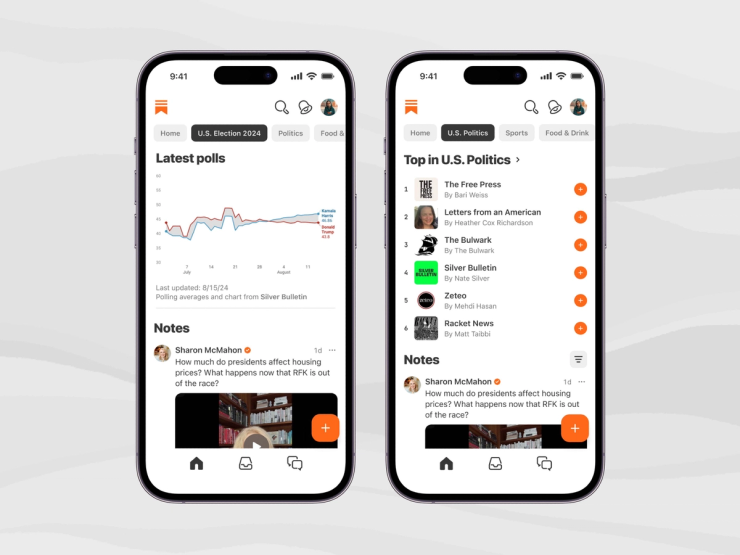The News
Seven years since its launch, the newsletter platform Substack has consolidated its dominance of the independent news business. Now, it’s trying to position itself as something more: a central platform for paying creators of all kinds, untethered to the news cycle and beyond the tough-to-monetize medium of text.
The company’s accomplishments are remarkable: Its recommendation network is responsible for 50% of all subscriptions and 30% of paid subscriptions, offering a strong argument for why writers should use Substack rather than technically similar but smaller competitors like Ghost and Beehiiv. The company told Semafor that live coverage on Substack of major news events such as President Joe Biden leaving the presidential race and the presidential debates have spiked subscription revenue by millions for its publishers.
And while it’s lost a few high-profile creators over its refusal to kick fringe or offensive voices off the platform, it has added more and now dominates the attention of media elites and political junkies, with top channels spanning Bari Weiss’ Free Press and Mehdi Hasan’s Zeteo, the Never-Trump site The Bulwark and the anti-establishment leftist outlet Drop Site News. When top journalists left the Washington Post and the Guardian in recent weeks, Substack was their obvious destination.
The company still isn’t profitable on an annual basis, and declined to say how much revenue has grown since it was reported to be a modest $9 million in 2022. But Substack has added more than a million paid subscribers over the last year. News content continues to account for the company’s largest segment of subscribers, and it has more in the pipeline.
To avoid fizzling the way competitors like Medium have, Substack is trying to become less a journalism platform and more a payment system for creators.
In recent months, the company has been reaching out to influencers, video creators and podcasters to convince them to join the platform. It doesn’t need beauty influencers, say, to all of a sudden become bloggers. But it does want to be the primary vehicle for paying creators regardless of medium.
The pitch is simple: YouTube and other platforms do not generate meaningful revenue for the vast majority of creators, and other ways of making money like brand deals can be inconsistent and subject to volatile ad market trends.
This repositioning has put Substack in more direct competition with services like Patreon, which largely still brands itself more as a way to financially support artists and musicians than the foundations of a subscription business. Substack recently convinced the popular men’s fashion and lifestyle podcast Throwing Fits to migrate from Patreon to Substack. Substack takes a 10% cut of payments, a higher fee than Patreon, which takes 8%. But it also allows Substackers to walk away with their email lists, which offers flexibility to creators who want to dip into offering paid memberships without getting stuck on any specific platform.
And the future of that business probably isn’t news. Instead, the new model Substacker may be more like Violet Witchel of Violet Cooks, a food and recipe influencer. Substack convinced Witchel to join in January. She was able to convince more than 100,000 subscribers to follow her from Instagram to Substack, signing up tens of thousands and converting them to paid subscribers. And Witchel’s revenue from Substack this year is triple her earnings from brand deals across her other social platforms, the company told Semafor — a number it touts to YouTube and TikTok creators it is trying to lure to the platform.
Max’s view
Substack has surpassed previous blogging platforms like Medium and Tumblr in becoming essential to consumers of journalism. I’m certainly one of them — while I’ve cut down my magazine and print subscriptions by bundling with Apple News, my Substack bill continues to balloon, reaching nearly $50 a month and climbing.
Whether Substack can effectively convince creators en masse to alter their businesses — and whether it can do a better job than giant platforms that require its stars to make content that performs on a massive scale — is less certain.
The notion that it’s a platform for supporting creators in general, rather than merely for news, could help justify its valuation — the company was reportedly valued at $650 million in a 2021 funding round — and open the door to a possible acquisition by someone other than media companies (which can’t afford it), and social platforms (which don’t want to get deeper into content). A Substack that emerges as a central hub for paying independent creators, by contrast, could be interesting to payment platforms like Stripe and Square.
But there are risks to this strategy, as well. Substack doesn’t offer the slickest video and audio features in the business. The popular podcast Search Engine launched on Substack, but eventually took its membership program to a membership platform that offered friendlier tools for podcasters.
Meanwhile, some of its core newsletter writers have found the shift grating. In August, Emily Sundberg observed in her business and culture newsletter, Feed Me, that Substack had become flooded with bad, diary-like blog posts attempting to monetize noise. Substack may not want its feed to be clogged with bad writing, but its business now depends on a lot more people who aren’t necessarily good writers bringing themselves and their audiences to Substack.
Another risk is that Substack continues to serve as a waystation for people between better gigs, contributing to subscriber churn. A few prominent Substackers told Semafor that while they were happy with the platform for now, at some point giving up 10% of their revenue every month probably won’t make sense.


